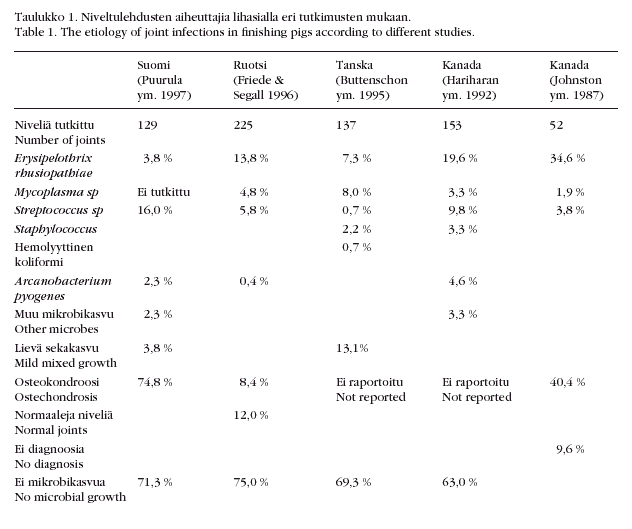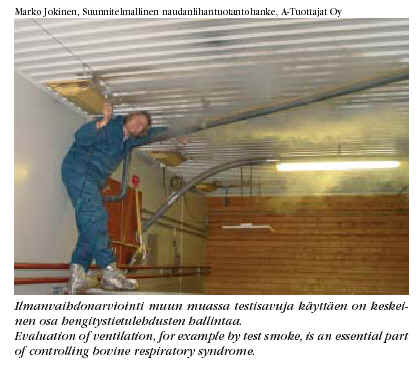
With other management procedures the restriction of bovine respiratory infections includes proper medical treatment of sick animals. Medical treatment has to be individually planned and evidence-based as far as possible. Medication has to be based on pharmacokinetic and pharmacodynamic knowledge, and attention must be paid also to possible increase in resistance to antimicrobials. Treatment has to be cost-effective. It is essentially important to begin treatment in time and to continue it long enough. With mild symptoms only, an antimicrobial treatment is recommended, but also non-steroidal anti-infl ammatory treatment has to be given when the symptoms are more severe. With severe symptoms, it is recommended to give non-steroidal anti-in- fl ammatory treatment intravenously. Medication can be continued and milder cases can be medicated subcutaneously, intramuscularly or per orally. Parenteral antimicrobial treatment is recommended and antibiotic of choice in Finland is either oxytetracycline or penicillin. Second-choice antibiotics are fl uoroquinolones or trimethoprim-sulfonamides. Penicillin is the antibiotic of choice for adult cattle, because in respiratory infections of adults mycoplasmas are usually clinically insignifi cant. Also other medical treatments can be considered with non-steroidal anti-infl ammatory drugs and antimicrobials when the patient can be carefully monitored. Not even good medical treatment can replace prophylactic procedures against respiratory infections and proper management of cattle.

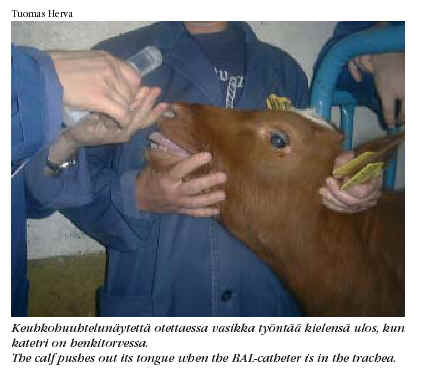
This review deals with the factors effecting decision making of treatment in post partum dysgalactia (PPDS; MMA) in the sow, based on evidence available in literature. The essence of patophysiology in this condition is endotoxemia resulting in clinical symptoms. The fi rst symptoms are commonly seen in the newborn piglets, which soon after birth start to starve and loose body condition. Thereafter, general symptoms are encountered in the dam: body temperature elevates and she looses her appetite and becomes lethargic with a sternal recumbency. Local symptoms found on a regular basis include those related to the udder: swelling, hyperemia, local increase in temperature and increase of the somatic cell count in milk. Sometimes vulvar discharge may be detected. Commencement of antimicrobial treatment should be based on the clinical picture as a whole, for instance, increased body temperature alone may not warrant antimicrobial theraphy, since elevated temperature is subject to such a high degree of physiological variation at parturition in the sow. Use of antimicrobials is indicated if generalized symptoms are present. In Finland, the antibacterials of choice in treatment of PPDS are sulfonamides and aminopenicillins. More broad spectrum antibacterials can be used, if necessary, based on sensitivity testing. In any case of PPDS, use of NSAID is always indicated as is the use of oxytocin for the milk let down. Fluid theraphy of piglets as well as the dam is an important part of treatment, especially in a serious case of PPDS.
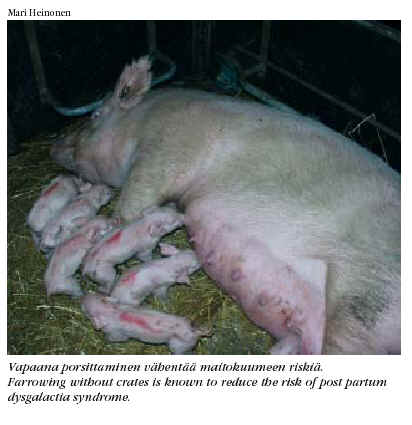
Treatment of mastitis during lactation is discussed in this article, with focus on clinical mastitis. Antimicrobial treatment of subclinical mastitis is not recommended in Finland, except for special reasons, e.g. if mastitis is very contagious. The recommendations how to treat clinical mastitis are based on published clinical studies and knowledge available on pharmacokinetics and pharmacodynamics of the antimicrobial substances. Before treatment, an aseptic milk sample is always taken for bacteriological examination. Clinical mastitis is in Finland mainly caused by gram-positive organisms. If the causing agent is susceptible for penicillin G, it should be used in the treatment. In Finland, all mastitis streptococci and major part of staphylococci are still susceptible for penicillin G. In mastitis, due to S. aureus, resistance to penicillin may be a problem, as in the survey in 2001 more than half of the isolates were resistant. Among isolates from clinical mastitis this fi gure may be lower. In a clinical material collected from the practice area of Saari Clinic, only 26 % of the S. aureus isolated were resistant to penicillin. Mastitis caused by streptococci and coagulase-negative staphylococci is recommended to be treated intramammarily, and the cure rates are generally high. In S. aureus mastitis, susceptibility to penicillin G affects both selection of treatment and prognosis for cure. Mastitis due to penicillin-susceptible strain is treated with concomitant intramammary and parenteral treatment, and prognosis is reliably good. In mastitis caused by penicillin-resistant strain, prognosis is poor. If the cow is treated, fi rst drug of choice is cloxacillin. In coliform mastitis, antimicrobials are recommended, if the bacterial growth in milk is heavy and the cow has serious clinical signs. The antimicrobial treatment is administered parenterally and the alternatives are enrofl oxacin or trimethoprim-sulfonamides in large doses. No clinical evidence is available on the effi cacy of the latter combination. The duration of antimicrobial treatment is from 3 to 5 days and the longest in mastitis caused by S. aureus or Str. uberis. Treatment should include non-steroidal anti-infl ammatory agents, which are recommended in particular in coliform and summer mastitis. Oxytocin can be administered if frequent milking-out is carried out. The owner is advised to follow-up the treatment response using CMT.
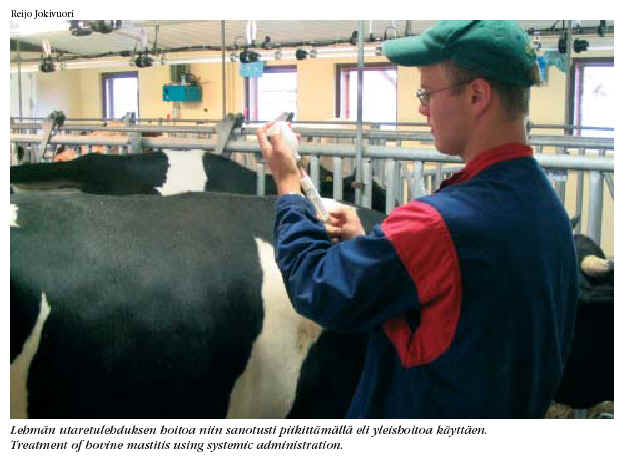
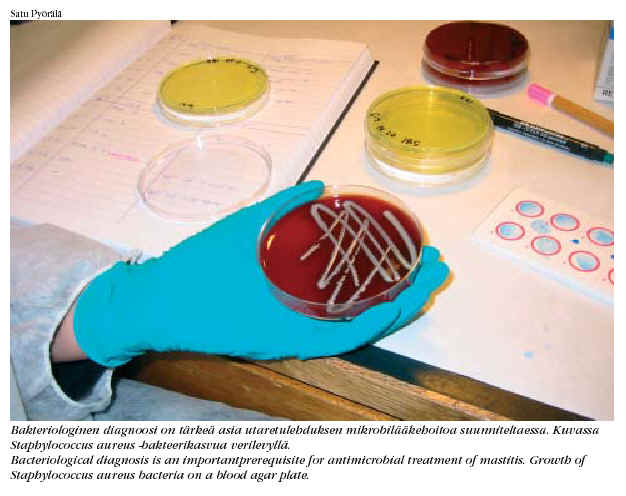
Antimicrobial therapy of cows at drying-off and its alternatives are discussed in this article. The aim of dry cow therapy is to eliminate infections present at drying-off, and to prevent new infections developing during the dry period. In many countries, blanket dry cow therapy is the method of choice to control mastitis. However, this practice has been questioned, since bulk milk somatic cell counts have markedly decreased and mastitis has changed from contagious to environmental. In the Nordic countries, selective dry cow therapy has always been used, and this is still the method of choice also in Finland. In selective dry cow therapy, only cows with high cell counts and cows particularly susceptible for mastitis are treated with antibiotics. The dry cow product used in each herd is selected on the basis of the bacteriological diagnoses and results from susceptibility testing from the herd. The fi rst drug of choice for dry cow therapy is penicillin G. Non-antibiotic approaches can be recommended in herds where the risk for environmental mastitis is high.
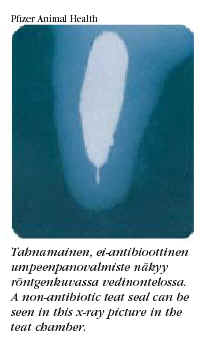
Tail-biting is a quite frequent problem in Finnish pig nurseries and fi nishing units. An estimated 10–30% of pigs are being bitten during their lifetime. Tail-biting decreases welfare and growing rate, causes mortality and is an important cause of rejections at slaughter. In acute cases, the biter and the victims are removed from the group, and animals with lesions are treated with antibiotics. Tail-biting spreads easily in the batch. It is a symptom of welfare problems, and therefore treatment should focus on identifi cation of causing factors.
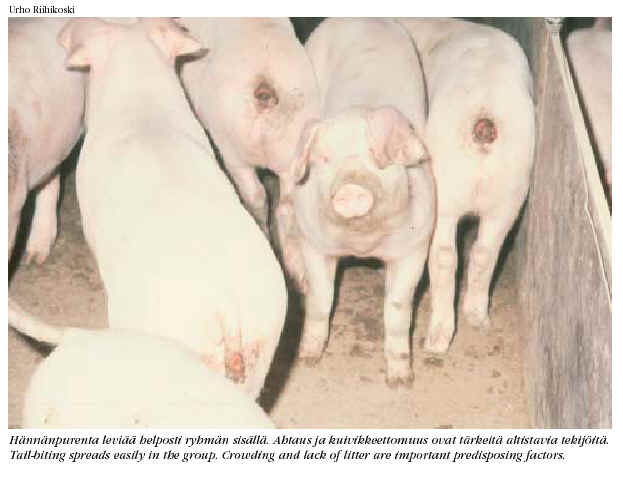
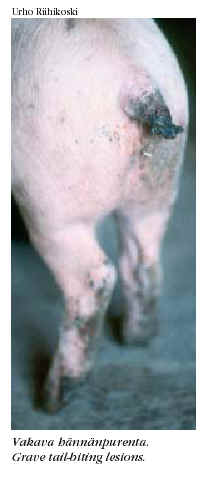
Treatment of joint infections in pigs. Joint infections cause considerable economic losses and impairment of animal welfare in pigs. Lame pigs should always be treated or culled. Treatment is based on using hospital pens, anti-infl ammatory drugs and antimicrobial drugs. Controlled experimental studies about treatments of porcine joint infections are not available.
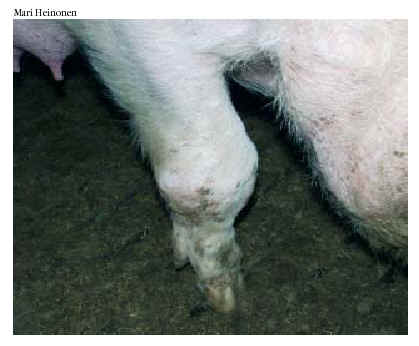 |
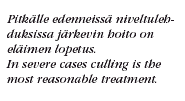 |
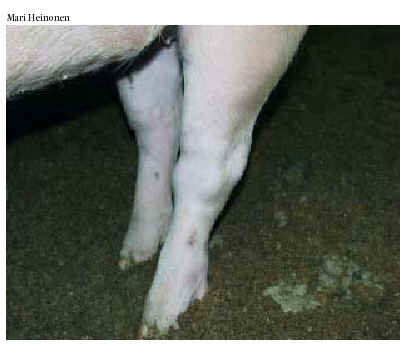 |
 |
